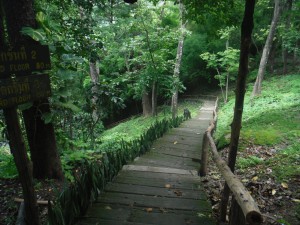One issue that frequently comes up when discussing ecology and the environment is the idea of the human population exceeding carrying capacity and taking every other species out with us. Population growth is an issue, as David Bloom’s 7 Billion and Counting emphasizes through its presentation of global population statistics including predicted growth and urbanization rates. There is not just the problem of more people inhabiting the planet though. Below, the issue of distribution and utilization of resources is discussed, as well as the ways humans change their environment for their own perceived gain whilst doing serious damage at times.

The Benefits of the Commons
Berkes, D. Feeny, B. J. McCay, J. M. Acheson argue in their article The Benefits of the Commons that Hardin’s model of the “tragedy of the commons” is incorrect. They believe that success in managing common property can be achieved in ways other than privatization or government control, citing research carried out in the years since Hardin created his model. They also use their own case studies to defend the idea that communities dependent on common-property resources have used a variety of institutional arrangements to manage their resources with a range of success in achieving sustainable use, with ecological sustainability being used as an index of management success. Berkes et al describe the two characteristics common-property resources have, creating a definition of common-property resources that states it is a class of resources for which exclusion is difficult and joint use involves subtractability. Their second step of analysis involved creating a taxonomy of property-rights regimes, defining open access, private property, communal property, and state property. Case studies of hunting, fishing, and forest resource management are discussed, with an emphasis on the competency of locals to regulate and manage their resources and, in the case of the Thai forest, the incompetency of government to regulate common-property. Berkes et al discuss the limits of Hardin’s model and how to improve it, acknowledging the ability of users to self-regulate use of the common-property. The authors need to clarify at the beginning what they mean by environmental sustainability as that term can have many meanings.

Seven Billion and Counting
David Bloom’s 7 Billion and Counting addresses the issue of population growth- mainly through giving statistics of different nations population sizes and growth (both current and predicted). He informs readers of the countries that currently hold the top two positions for largest population (China with 1.35 billion people, India with 1.24 billion). He goes on to discuss the UN Population Division discussing population growth and stating that less developed regions have been experiencing higher population growth than more developed regions for a long time. According to Bloom, nearly 97% of the 2.3 billion increase in population projected to occur by 2050 will take place in the less developed regions of the world. The most economically fragile countries will bear the brunt of the population growth, while Europe’s growth will remain flat. Bloom continues to give statistics of population growth, including the density of regions- Asia has a population density of 132 people per km2, which is higher than that of Africa, Europe, and Latin America and the Caribbean. Overall, Bloom gives a number of useful facts for population growth, including predicted areas of heavy growth and data on urbanization, but the information is presented with little to no interpretation. He does not present an argument, just raw data for the reader to digest and analyze on their own. Bloom does not present an opinion, but instead disseminates the information regarding the amount of space humanity will occupy in the future and where the least amount of space available per body will be.

The Bhopal Disaster and Corporate Culture
Bhopal: Vulnerability, Routinization, and the Chronic Disaster written by S. Ravi Rajan provides readers with the story of Bhopal, India and the chemical disaster that destroyed the community. A gas leak from a factory owned by the Union Carbide Company killed thousands, and caused cancer in survivors. A company background is provided, including their decision to open a plant in Bhopal in 1969, and the regulations they failed to follow (namely putting the MIC unit next to a densely populated neighborhood and heavily used railway station, as well as neglecting to put in appropriate safety features and creating a management culture that did not pay attention to safety, both factors resulting in between half and two-thirds of the engineers hired when the plant was commissioned resigning and being replaced by those less skilled and under-qualified). After the leak, Union Carbide managed to leave Bhopal ruined but the shareholders better off- the company was restructured and a settlement was made with the Indian government that was not enough to handle the victims’ medical costs. Rajan presents an account looking less at the events taking place in Bhopal after the spill, but more at how Union Carbide responded, or rather did not respond, to the emergency. He did discuss advocacy for victims, and the idea of corporate cultures existing and the study of them so they may be held accountable for their actions. Rajan addresses the issue of organization and the body, and the culture surrounding new structures of interaction and responsibility.

The Body, the Chemical-Lawn, and the Search for Social Acceptance
The Lawn-Chemical Economy and Its Discontents, written by Paul Robbins and Julie Sharp, is an analysis of the use of chemicals in maintaining “healthy” lawns. The authors discuss the green-washing of chemical companies, such as changing their names from things like Spraytech and Chemlawn to the more eco-friendly sounding Greenspace Services, as well as the expanse of the chemical-lawn monoculture. The chemical-lawn monoculture contains aesthetics such as a grassy pastoral area, utilizing non-native species in areas where native species could thrive. The maintenance of a chemical-lawn monoculture is high-input, forcing homeowners to remove weeds and spray the land with chemicals that research has shown to be commonly tracked in homes, are persistent in indoor environments, accumulate in dust on surfaces and carpets, lead to persistent contamination on clothing, and may be more dangerous to children than initially assumed due to chronic exposure. The authors also discuss to a large extent the social context of the chemical-lawn, presenting information on how a lawn is interpreted in the neighborhood (“representing a public statement about private behavior” as they put it), demonstrating class values in middle-class neighborhoods through property values. According to Robbins and Sharp, local enforcement is not the only director of high-input ecologies; chemical industries also shape the ecology. The authors also discuss alternatives to the chemical-lawn and resistance movements against the high-input lawn as well. The authors present through citations of scholarly research a background on individuals searching for status in property through chemicals and the damage chemical companies do.

Carrying Capacity as Folk Model
Carrying Capacity’s New Guise: Folk Models for Public Debate and Longitudinal Study of Environmental Change by Lisa Cliggett addresses the faults in the carrying capacity model. Cliggett suggests we reframe carrying capacity as a folk model as it does not successfully capture the multifaceted process of the human-environment link, and it tends to blame the victim. Cliggett cites the Gwembe Tonga Research Project (GTRP), which is the longest and most systematic longitudinal studies in Africa, studying the displacement of villages that had to move approximately 100 miles downstream after the construction of the artificial Lake Kariba. Cliggett defines carrying capacity as the maximum number people that a given land area will maintain in perpetuity under a given system of usage without land degradation setting in. She also provided a list of some of the problems most often cited in literature on carrying capacity as well, including the assumption of equilibrium, difficulty in measuring food resources, inability to account for human preference in taste and labor expenditure, assumption of full use of food resources, assumption of homogeneity across the landscape, assumption of an isolated group/region, an ahistorical view of a process that fluctuates in short- and long-term time frames, and the concept not addressing the issue of the standard of living. The main concern with carrying capacity is that it generalizes a complexity of interactions that cannot be glossed over- and carrying capacity can rise through society and technology. Carrying capacity is difficult to measure as well especially as people have a variety of ways of coping with scarcity of resources.
Moral Economy, Food, and Transnational Peasant Movements

(Image by Author)
Bringing the Moral Economy back in . . . to the Study of 21st-Century Transnational Peasant Movements by Marc Edelman discusses national and international agriculture. According to Edelman, global networks of peasant and small farmer organizations link coalitions of national groups that operate across boarders. He provides a brief history of the formation of the transnational movement, citing the main drive for organizing as the 1980s world farm crisis that was set off by the liberalization of global agricultural trade. Farmers fought with giant corporations over intellectual property rights, and a transnational coalition called Via Campesina was formed. The coalition has a highly heterogeneous membership, and its political campaigns and demands focus on human rights, sustainable agriculture, agrarian reform, and biodiversity and genetic resources.
Edelman states that they want to take agriculture out of the World Trade Organization, as agricultural production is a means of livelihood and nourishment for peasants and small farmers, most of the world’s agricultural output is consumed domestically, and the World Health Organization is undemocratic and unaccountable, among other accusations. Among their other demands, there is the request for “just prices,” which Edelman defines as a transnational norm as opposed to a local norm, as well as “food sovereignty,” which they hope will replace “food security.” “Food security” refers to all people at all times have physical and economic access to adequate nutritious food, while “food sovereignty” prioritizes local production and peasant access to land, and upholds nation’s rights to implement supply management policies.

(Image by Author)
Agrarian Change
David Grigg provided in his article Ester Boserup’s Theory of Agrarian Change: A Critical Review an analysis of Boserup’s argument. Boserup claimes that population pressure is a major cause of change in land use, agrarian technology, land tenure systems, and settlement forms. She states that any given area will go through a series of stages of rising land use intensity, with the general trend being that as total output increases, output per head decreases. Boserup believes that economic growth is possible within traditional agriculture, though there are some assumptions made. Grigg’s actual critiques come in when he is listing the assumptions associated with Boserup, though some of the critiques he has he admits are addressed in her later works. The assumptions made by Boserup are as follows: population growth is taken as a given, though it is independent of food supply. Grigg mentions the improved medicine being one reason population increased, while commenting that Boserup argues but does not explore in detail the possibility that population may decrease and cause a change from intensive to extensive agriculture. The theory is confined to pre-industrial societies and excludes farmers who fit certain criteria, farmers are interested first in obtaining enough food and second in maximizing leisure, farmers at any given point area assumed to be aware of a wider range of techniques than those they practice, and spatial variations in land use intensity are assumed to reflect only variations in population pressure. Finally, many peasants may be reluctant to adopt a more intensive system not just because annual labor inputs are higher but because the labor is needed to create capital requirements is excessive.
Trapped in a Coal Mining Town

(Image by Author)
Robert Todd Perdue and Gregory Pavela wrote their article Addictive Economies and Coal Dependency Methods of Extraction and Socioeconomic Outcomes in West Virginia on coal extraction in the Appalachian region. In their research, the authors found that coal mining dependent counties have higher rates of poverty and unemployment than other counties. There are two different types of mines- underground and mountain top removal. Mountain top removal destroys scenic mountains and their ecosystems, though they are they less common mine. Underground mines do not come without their own troubles- they typically have a longer legacy of mining, meaning their resources have likely already depleted to minimal amounts. The authors urge people living in the Appalachian region to move away from coal dependency as the world is already transitioning into other sources of fuel. There is little money to be made from coal mining in those regions because coal extraction is a primary industry, meaning coal is pulled from the ground, cleaned, and shipped to another location. The jobs may be thought of as good for the miners financially, but they ignore the risks to their bodies. The health of the miners is of course a risk- black lung has replaced mining accidents for the top killer of mine workers. Coal dust does not just affect the miners though- coal is a pollutant and the burning of it or chipping of it can damage the lungs. Using coal for utilities is unattractive due to increased regulation and pollution control costs as well.

